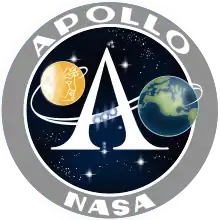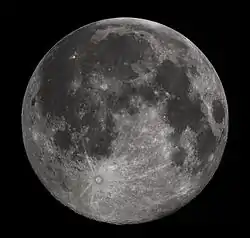Apollo 11 lunar sample display
The Apollo 11 lunar sample display is a commemorative podium style plaque display consisting of four rice-size dust particle specimens (dubbed "Moon rocks"), the recipient's flag and two small metal plates attached with descriptive messages. The Apollo 11 podium style commemorative wooden plaque displays were given out as gifts in 1970 by President Richard Nixon to 135 countries worldwide, the 50 states of the United States and its territories.[1][2]
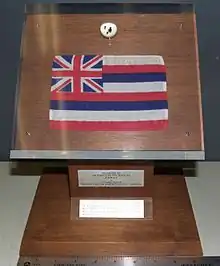
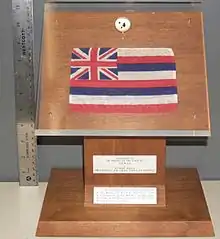
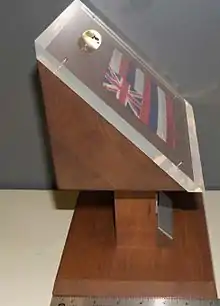
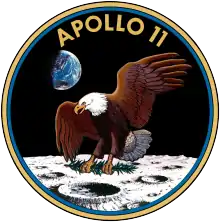 |
| Part of a series on |
| Apollo 11 |
|---|
|
History
President Richard Nixon asked NASA in November 1969 to make up about 250 presentation displays for 135 nations, the 50 United States and its possessions, and the United Nations that were to receive these displays. Each display included Moon dust from the Apollo 11 first crewed lunar landing mission that were collected by Apollo 11 astronauts Neil Armstrong and Buzz Aldrin in 1969. The rice-sized particles were four small pieces of Moon soil weighing about 50 mg total and were enveloped in a clear acrylic button about as big as a United States half dollar coin. This acrylic button magnified the grains of lunar pebbles. The Apollo 11 lunar sample displays were given out as goodwill gifts by Nixon in 1970. Lunar dust soil from the Apollo 11 mission and samples of lunar basalt 70017 of the Apollo 17 mission were mounted on wooden plaque displays for the countries of the world and the United States.[1][2][3]
Description
The Apollo 11 lunar sample display is a small podium of 9 inches across and 11 inches high. An acrylic plastic button containing lunar sample Moon rocks (Moon soil dust particles like four small grains of rice) is mounted to a wooden board face plate approximately 9 inches square. The podium display also had mounted on it the recipient's country or state flag (4 inches × 6 inches) (10.16 cm × 15.24 cm)[4] that had been to the Moon and back that laid directly below the acrylic plastic button container. The nylon flag was covered by a half inch clear plastic cover. The small podium display plaque was given to the people of the respective country or state as a gift by United States President Richard Nixon. All 135 countries worldwide received the display, as did the 50 states of the United States and the U.S. provinces. The United Nations also received this Apollo 11 display.[1]
Each presentation display had a message to that nation or state from Nixon explaining it was a gift to them. The message explained that the Moon soil material came from the Apollo 11 mission and that their flag was carried to the Moon and back on the first manned mission. It later was discovered that Venezuela's was not flown to the Moon. This was corrected by each of the nation's flags being carried on Apollo 12 and wording changed that their flag "was carried to the Moon and back" without specifying on which Apollo mission.[1]
The messages at the bottom of the wooden podium plaque display read:
"Presented to the people of California by Richard Nixon, President of the United States of America.
"This flag of your state was carried to the Moon and back by Apollo 11 and this fragment of the Moon's surface was brought to Earth by the crew of that first manned lunar landing."
If the wooded display went to a country of the world instead of one of the states of the United States then the word "state" was replaced with "nation" or "kingdom".[1]
Ownership
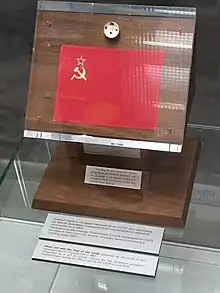
Once the displays were given, they became the property of the recipient,[5] and were no longer subject to tracking by NASA. All other lunar sample locations are well documented by the US space agency to this day (with exception to similarly presented Apollo 17 lunar sample displays). NASA no longer gives away any Moon material and tracks all Moon soil material and Moon rocks, with the Apollo 11 and Apollo 17 display gifts being the only exceptions.[5] NASA keeps meticulous records on all other lunar samples worldwide. The Apollo 11 Moon rock fragment sample displays then came under the public gifts laws of the nation or state that received the display. In the case of each state of the United States public gifts cannot be legally transferred to individual ownership unless certain additional legislation allows it.[1]
Countries
The recipients were 135 foreign countries, the 50 United States and its provinces, and the United Nations. The nation or state that received the Moon rock display also had its flag taken to the Moon and back by the crew of Apollo 11. The flag was mounted in the center of the commemorative plaque display with a message label below it saying it was a gift to the recipient.[1]
The worldwide countries during Nixon's presidency that the plaques were given to were Afghanistan, Albania, Algeria, Andorra, Argentina, Australia, Austria, Barbados, Belgium, Bhutan, Bolivia, Botswana, Brazil, Bulgaria, Burma, Burundi, Cameroon, Canada, Cambodia, Central African Republic, Ceylon (Sri Lanka), Chad, Chile, China, Colombia, Congo (Brazzaville), Congo (Kinshasa), Costa Rica, Cuba, Cyprus, Czechoslovakia, Dahomey, Denmark, Dominican Republic, Ecuador, Egypt, El Salvador, Equatorial Guinea, Ethiopia, Finland, France, Gabon, Gambia, Germany, Ghana, Greece, Guatemala, Guinea, Guyana, Haiti, Honduras, Hungary, Iceland, India, Indonesia, Iran, Iraq, Ireland, Israel, Italy, Ivory Coast, Jamaica, Japan, Jordan, Kenya, Korea, Kuwait, Laos, Lebanon, Lesotho, Liberia, Libya, Liechtenstein, Luxembourg, Madagascar, Malawi, Malaysia, Maldives, Mali, Malta, Mauritania, Mauritius, Mexico, Monaco, Mongolia, Morocco, Muscat and Oman, Nauru, Nepal, Netherlands, New Zealand, Nicaragua, Niger, Nigeria, Norway, Pakistan, Panama, Paraguay, Peru, Philippines, Poland, Portugal, Romania, Rwanda, San Marino, Saudi Arabia, Senegal, Sierra Leone, Singapore, Somalia, South Africa, Southern Yemen, Soviet Union, Spain, Sudan, Swaziland, Sweden, Switzerland, Syria, Taiwan, Tanzania, Thailand, Togo, Trinidad and Tobago, Tunisia, Turkey, Uganda, United Kingdom, Upper Volta, Uruguay, Vatican City, Venezuela, Vietnam, Western Samoa, Yemen, Yugoslavia, and Zambia.[1][2]
Fate
Once the goodwill display with the Moon material was presented NASA offered no counseling or recommendations on how the caretaker or curator was to handle the Moon rocks.[5] Their fate was in the hands of the recipient, which in many cases was not well managed.[6] NASA did not give away any Moon rock displays other than what was given of the Apollo 11 and Apollo 17 Moon rock displays.[5]
Certain samples of Moon rock and lunar dust soil from the Apollo 11 and Apollo 17 missions, mounted on the wooden plaque displays especially for Brazil, Canada, Cyprus, Honduras, Ireland, Malta, Netherlands, Nicaragua, Norway, Romania, Spain, Sweden, Alaska, Arkansas, California, Colorado, Delaware, Hawaii, Illinois, Missouri, Nebraska, New Jersey, New Mexico, New York, North Carolina, Oregon, West Virginia were later reported missing by many of the recipients.[1][2][3] Since 2005 certain entities and key people have made concerted efforts to find the current locations of all the Apollo lunar sample displays with the goodwill Moon rocks.[7][8][9][10][11] One such person is Joseph Gutheinz (former NASA Office of Inspector General special agent for 10 years), who was a professor at the University of Phoenix in Arizona, USA.[12] Gutheinz even went to the extreme of having his hundreds of students try to locate all these displays. Another space history expert tracking the goodwill lunar displays is Robert Pearlman, founder and editor of collectSPACE, a website devoted to space-related artifacts and memorabilia.[13]
See also
References
- Pearlman, Robert (1999–2012). "Where today are the Apollo 11 goodwill lunar sample displays?". collectspace.com. Retrieved November 2, 2012.
- Pearlman, Robert (1999–2012). "Where today are the Apollo 17 goodwill lunar sample displays". collectspace.com. Retrieved November 2, 2012.
- Earth magazine, March 2011, pp. 42-51
- "1969.09.19 - MSC reports that 136 flags of other nations were flown on Apollo 11". Encyclopedia Astronautica. Archived from the original on October 6, 2012. Retrieved November 2, 2012.
- Pazmino, John (December 18, 2009). "Where are the moonrocks?". nyskies.org. NYSkies Astronomy Inc. Retrieved November 2, 2012.
- Fernandez, Manny (January 21, 2012). "NASA Searches for Loot That Traveled From Space to Another Void". The New York Times. Houston, Texas. Retrieved November 3, 2012.
- Associated Press (May 14, 2012). "Houston lawyer on quest for missing moon rocks". Buffalo, Texas. Retrieved November 3, 2012 – via Fox News.
- "Review: The Case of the Missing Moon Rocks". Retrieved November 3, 2012.
- Kloc, Joe (February 19, 2012). The Case of the Missing Moon Rocks. The Atavist/Amazon Digital Services, Inc. p. 47. ASIN B007BGZNZ8. Retrieved November 3, 2012.
- "Customs agents seize 4 billion year old moon rock". cnn.com. CNN. December 7, 1998. Retrieved November 3, 2012.
- Hennessy-Fiske, Molly (February 7, 2012). "Finding lost moon rocks is his mission". Los Angeles Times. Retrieved November 3, 2012.
- "One man's quest to find missing moon rocks". Detroit Free Press. Buffalo, Texas. 2012-05-14. Retrieved November 3, 2012.
- Pearlman, Robert (1999–2012). "Robert Pearlman - Founder and Editor". collectSPACE. collectspace.com. Retrieved November 3, 2012.
